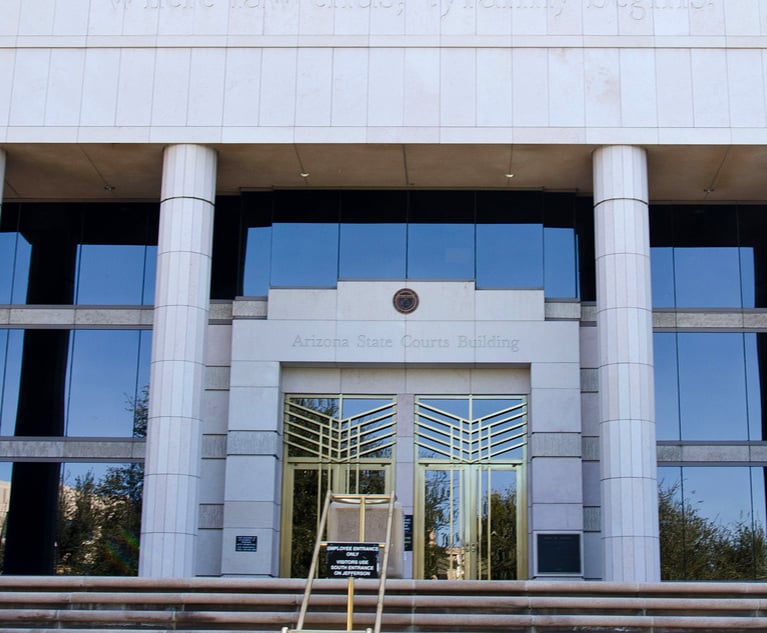Commentary: Banking regulation work emerges as the new private equity
Has there ever been a better time be a specialist in financial services regulation? For years, such lawyers toiled away little-noticed within a dozen or so major commercial firms, prospering in sizeable numbers in Allen & Overy (A&O), Clifford Chance (CC) and CMS Cameron McKenna. But despite the creation of the Financial Services Authority (FSA) a decade ago, this group was hardly the most visible or loved of its breed, despite in recent years enjoying some of the highest charge-out rates in the City.
December 03, 2008 at 09:25 PM
4 minute read
City firms discover love for humble regulation lawyers as the FSA gears up for intrusive stance
 Has there ever been a better time be a specialist in financial services regulation? For years, such lawyers toiled away little-noticed within a dozen or so major commercial firms, prospering in sizeable numbers in Allen & Overy (A&O), Clifford Chance (CC) and CMS Cameron McKenna. But despite the creation of the Financial Services Authority (FSA) a decade ago, this group was hardly the most visible or loved of its breed, despite in recent years enjoying some of the highest charge-out rates in the City.
Has there ever been a better time be a specialist in financial services regulation? For years, such lawyers toiled away little-noticed within a dozen or so major commercial firms, prospering in sizeable numbers in Allen & Overy (A&O), Clifford Chance (CC) and CMS Cameron McKenna. But despite the creation of the Financial Services Authority (FSA) a decade ago, this group was hardly the most visible or loved of its breed, despite in recent years enjoying some of the highest charge-out rates in the City.
All that changed last year with the collapse of Northern Rock and the ensuing chaos which thrust such advocates into the headlines. And the rising status of bank regulation lawyers has been even more obvious since the collapse in September of Lehman Brothers. There is no doubt that the unchallenged regulatory prowess of Sullivan & Cromwell and Cleary Gottlieb Steen & Hamilton has helped both firms snap up a string of choice post-Lehman mandates.
This side of the pond, the prominence of Freshfields Bruckhaus Deringer's Michael Raffan advising the Bank of England during numerous market interventions has probably been the most high-profile illustration of the importance of such adviser's counsel.
With the FSA ushering in a more intrusive style of regulation, putting more weight on the market significance of financial institutions rather than focusing resources on the most 'risky' businesses, demand for the limited pool of such specialists is set to soar.
Some upwardly mobile firms such as Berwin Leighton Paisner (BLP) have already moved to position themselves, with the firm recently recruiting A&O's regulatory investigation chief Sidney Myers. And established leaders in the field have also moved to expand their ranks, with CC, for example, hiring Russell Jones & Walker's respected regulatory specialist Judith Seddon, who will join its eight-partner group in London.
Others are specifically targeting high-stakes enforcement actions and cases involving criminal sanctions; last month Reynolds Porter Chamberlain picked up former FSA wholesale enforcement manager Steven Francis. LG, meanwhile, also strengthened its regulations practice after hiring Richard Everett, a former senior lawyer with the regulator, and Barlow Lyde & Gilbert recently hired FSA lawyer Emily Benson.
A related trend has seen firms target so-called criminal regulatory services (CRS). BLP recently drew a team of 11 lawyers to tackle CSR issues, while CC, Weightmans, Weil Gotshal & Manges and Wragge & Co are all active in the area.
Of course, no-one is sure which areas of regulation will be most in demand, other than that there will be more of it in general, with the FSA now projecting an increase in its staff from around 2,500 to 3,000 by 2010.
But despite an increase in resources and the FSA moving to step up its until-now rare use of outside lawyers – the regulator currently spends around £500,000 a year on legal fees, some of it with Norton Rose and Ashurst – the real interest for law firms will be in counselling shell-shocked banks as they become acquainted with a more robust form of oversight than they have been used to. And aside from the pure regulation play, such practices are often key in winning big-ticket banking mergers, especially those put together in haste amid market turmoil. Linklaters last year saw lucrative US regulatory duties for Royal Bank of Scotland turned over to Shearman & Sterling on the takeover of ABN Amro as it lacked such a team in the US. Unsurprisingly, the firm is now looking to hire in the area.
This content has been archived. It is available through our partners, LexisNexis® and Bloomberg Law.
To view this content, please continue to their sites.
Not a Lexis Subscriber?
Subscribe Now
Not a Bloomberg Law Subscriber?
Subscribe Now
NOT FOR REPRINT
© 2025 ALM Global, LLC, All Rights Reserved. Request academic re-use from www.copyright.com. All other uses, submit a request to [email protected]. For more information visit Asset & Logo Licensing.
You Might Like
View All
KPMG's Bid To Practice Law in US On Hold As Arizona Court Exercises Caution

Combative Arguments at EU's Highest Court Over Google's €4.13B Antitrust Fine Emphasize High Stakes and Invoke Trump
4 minute read
Law Firms 'Struggling' With Partner Pay Segmentation, as Top Rainmakers Bring In More Revenue
5 minute readTrending Stories
- 1Uber Files RICO Suit Against Plaintiff-Side Firms Alleging Fraudulent Injury Claims
- 2The Law Firm Disrupted: Scrutinizing the Elephant More Than the Mouse
- 3Inherent Diminished Value Damages Unavailable to 3rd-Party Claimants, Court Says
- 4Pa. Defense Firm Sued by Client Over Ex-Eagles Player's $43.5M Med Mal Win
- 5Losses Mount at Morris Manning, but Departing Ex-Chair Stays Bullish About His Old Firm's Future
Who Got The Work
J. Brugh Lower of Gibbons has entered an appearance for industrial equipment supplier Devco Corporation in a pending trademark infringement lawsuit. The suit, accusing the defendant of selling knock-off Graco products, was filed Dec. 18 in New Jersey District Court by Rivkin Radler on behalf of Graco Inc. and Graco Minnesota. The case, assigned to U.S. District Judge Zahid N. Quraishi, is 3:24-cv-11294, Graco Inc. et al v. Devco Corporation.
Who Got The Work
Rebecca Maller-Stein and Kent A. Yalowitz of Arnold & Porter Kaye Scholer have entered their appearances for Hanaco Venture Capital and its executives, Lior Prosor and David Frankel, in a pending securities lawsuit. The action, filed on Dec. 24 in New York Southern District Court by Zell, Aron & Co. on behalf of Goldeneye Advisors, accuses the defendants of negligently and fraudulently managing the plaintiff's $1 million investment. The case, assigned to U.S. District Judge Vernon S. Broderick, is 1:24-cv-09918, Goldeneye Advisors, LLC v. Hanaco Venture Capital, Ltd. et al.
Who Got The Work
Attorneys from A&O Shearman has stepped in as defense counsel for Toronto-Dominion Bank and other defendants in a pending securities class action. The suit, filed Dec. 11 in New York Southern District Court by Bleichmar Fonti & Auld, accuses the defendants of concealing the bank's 'pervasive' deficiencies in regards to its compliance with the Bank Secrecy Act and the quality of its anti-money laundering controls. The case, assigned to U.S. District Judge Arun Subramanian, is 1:24-cv-09445, Gonzalez v. The Toronto-Dominion Bank et al.
Who Got The Work
Crown Castle International, a Pennsylvania company providing shared communications infrastructure, has turned to Luke D. Wolf of Gordon Rees Scully Mansukhani to fend off a pending breach-of-contract lawsuit. The court action, filed Nov. 25 in Michigan Eastern District Court by Hooper Hathaway PC on behalf of The Town Residences LLC, accuses Crown Castle of failing to transfer approximately $30,000 in utility payments from T-Mobile in breach of a roof-top lease and assignment agreement. The case, assigned to U.S. District Judge Susan K. Declercq, is 2:24-cv-13131, The Town Residences LLC v. T-Mobile US, Inc. et al.
Who Got The Work
Wilfred P. Coronato and Daniel M. Schwartz of McCarter & English have stepped in as defense counsel to Electrolux Home Products Inc. in a pending product liability lawsuit. The court action, filed Nov. 26 in New York Eastern District Court by Poulos Lopiccolo PC and Nagel Rice LLP on behalf of David Stern, alleges that the defendant's refrigerators’ drawers and shelving repeatedly break and fall apart within months after purchase. The case, assigned to U.S. District Judge Joan M. Azrack, is 2:24-cv-08204, Stern v. Electrolux Home Products, Inc.
Featured Firms
Law Offices of Gary Martin Hays & Associates, P.C.
(470) 294-1674
Law Offices of Mark E. Salomone
(857) 444-6468
Smith & Hassler
(713) 739-1250









